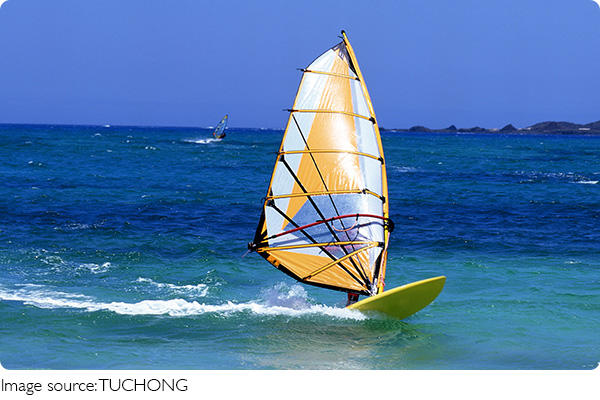Master Windsurfing NOW!

Welcome Lykkers! Windsurfing is an exhilarating water sport that combines the thrill of surfing with the excitement of sailing.
For beginners, it can seem intimidating at first.
But with the right guidance and a bit of practice, you’ll soon be riding the waves with confidence. This guide breaks down everything you need to know to get started with windsurfing!
1. Understanding the Basics of Windsurfing
Windsurfing involves riding a board while holding onto a sail that catches the wind. The key to controlling the board and sail is balance, body positioning, and the ability to read the wind. To start, you’ll need the proper equipment: a windsurfing board, a sail, and a mast. As a beginner, you may want to start with a larger board that provides more stability, making it easier to learn how to balance.
The board is equipped with a fin that helps you steer. The sail, attached to a mast, catches the wind and propels you forward. The key to mastering windsurfing is to learn how to use the wind's power to your advantage without losing control.

2. Choosing the Right Equipment for Beginners
For first-timers, selecting the right gear is crucial. Beginners should opt for a board with a wider base and larger sail, which provide better stability and control. A bigger sail makes it easier to catch the wind, while a wider board helps maintain balance. Many rental shops provide beginner packages with stable boards and smaller sails, making it easier to start with equipment designed for learning.
If possible, choose a rig designed for lighter winds, as high winds can be more challenging and intimidating. For the sail, look for one that’s lighter in weight, which will help with maneuvering. The mast should be adjustable so that you can adjust the rig to your skill level.
3. Finding the Ideal Location
The best places to windsurf as a beginner are those with flat water and gentle winds. Avoid locations with strong waves or gusty winds, as these can make learning difficult and frustrating. Many beaches around the world have designated windsurfing areas, often with calm waters that provide the perfect environment for practicing. If you’re unsure where to go, consider taking a lesson at a local windsurfing school where instructors will provide both equipment and guidance.
When you’re ready to practice, always check the weather forecast for wind speed and direction. Winds between 10-15 mph are generally ideal for beginners, as they provide enough power without being overwhelming.
4. Learning the Basic Techniques
The first step in learning windsurfing is mastering the “up-haul” technique. This involves pulling the sail out of the water and getting your board up to speed. The up-haul is essential for getting started on the water and will allow you to become familiar with handling the sail and balancing on the board.
Once you’re comfortable with up-hauling, the next step is learning how to steer. Start by practicing on a straight path and try to maintain a steady course. To turn the board, you’ll need to use the wind's pressure on the sail to change direction. This is called “tacking” (for turning upwind) and “jibing” (for turning downwind). Both require precise control of the sail and body positioning to maintain balance and direction.

5. Mastering Balance and Body Positioning
Balance is key in windsurfing. You’ll need to learn how to shift your body weight to maintain control while keeping your feet planted firmly on the board. Start by focusing on keeping your body relaxed and your knees slightly bent for better control. Look ahead, not at your feet, as this helps with maintaining stability.
To steer, you’ll need to shift your weight to the back of the board when turning downwind, or to the front when going upwind. Your hands also play a crucial role in directing the sail. The front hand controls the angle of the sail, while the back hand helps you balance and adjust the power of the wind. Keeping your movements smooth and controlled will help you stay stable as you ride.
6. Progressing to Catching Waves
Once you've gained confidence in the basic skills, you’ll be ready to try catching waves. Start by practicing on smaller waves that are easier to manage. As you approach a wave, you need to focus on your timing and positioning. The key to riding a wave is to maintain speed while staying balanced.
You’ll need to adjust your sail angle to ensure that the wind keeps propelling you forward as you ride the wave. With practice, you’ll begin to understand how to position yourself to maximize the wave’s power and speed.
7. Safety Tips for Beginners
As with any water sport, safety is important in windsurfing. Always wear a life jacket, especially when you’re starting out. It’s also a good idea to use a helmet to protect yourself from any falls or collisions. Before heading out, make sure you’re familiar with the area, especially if you’re learning in the ocean where currents and tides can affect your experience.
Additionally, be mindful of other windsurfers, boaters, and swimmers. Windsurfing requires plenty of space to maneuver, so always check that the area is clear of obstacles. If you’re new, consider taking lessons with a certified instructor to ensure you’re practicing the sport safely and correctly.
Windsurfing offers an incredible combination of adventure, exercise, and fun. By understanding the basics, choosing the right equipment, and practicing key techniques, beginners can quickly gain the skills needed to enjoy this thrilling sport. Remember, learning to windsurf takes time, patience, and practice, but with each wave you catch, the feeling of freedom and excitement will make it all worth it.
Whether you’re seeking an adrenaline rush or just want to enjoy the beauty of the water, windsurfing offers something for everyone!
Feedback
0/1000

 · Sport Team
· Sport Team